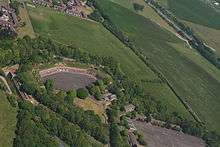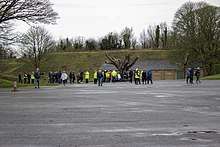Fort Burgoyne
Fort Burgoyne, originally known as Castle Hill Fort,[1] was built in the 1860s as one of the Palmerston forts around Dover in southeast England. It was built to a polygonal system with detached eastern and western redoubts, to guard the high ground northeast of the strategic port of Dover, just north of Dover Castle. The fort is named after the 19th century General John Fox Burgoyne, Inspector-General of Fortifications and son of the John Burgoyne who fought in the American Revolutionary War.

After the First World War Fort Burgoyne was used as a military depot or store for Connaught Barracks.[2] Until recently the central part of the fort was still owned by the Ministry of Defence, forming part of the Connaught Barracks site, which is now being redeveloped for housing.[3]
The eastern and western outworks are accessible if you contact the Land Trust, who now own the fort.[1]
The site also includes 104 acres (42 hectares) of land.[1]
Waking The Giant

On the 29th of February 2020, Fort Burgoyne was opened to the public for a day. The event was called Waking the Giant and was run by Albion Inc, as part of a commission for Pioneering Places East Kent to map out the future uses of the fort. The event featured: The Museum Of British Folklore, Weaving & Knitting by Robert George Sanders & Katherine Woodward, Blacksmithing by Michael Hart, Ceramics by Ceramic Art Dover & Keith Brymer-Jones, A showing of the film Fortopia By Matt Rowe, A demo of the Virtual Reality Game Escape created by Jake Price, A presentation of future fort use By Centeral St. Martins, A Makers Market by Future Foundry and Food & Drink by The White Cliffs & Real Deal Roasters.
The Event was considered a huge success by Albion Inc & Pioneering Places East Kent, with an estimated over 2000 people in attendance.
References
- "Fort Burgoyne: Dover fortress transferred to Land Trust". bbc.co.uk. 19 March 2014. Retrieved 25 March 2014.
- "Fort Burgoyne". Historic England. Retrieved 3 December 2015.
- "Public consultation on pre-application plans for former Connaught Barracks site". Invest in Dover. 7 November 2014. Retrieved 3 December 2015.